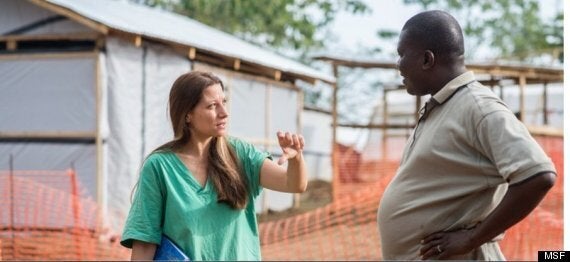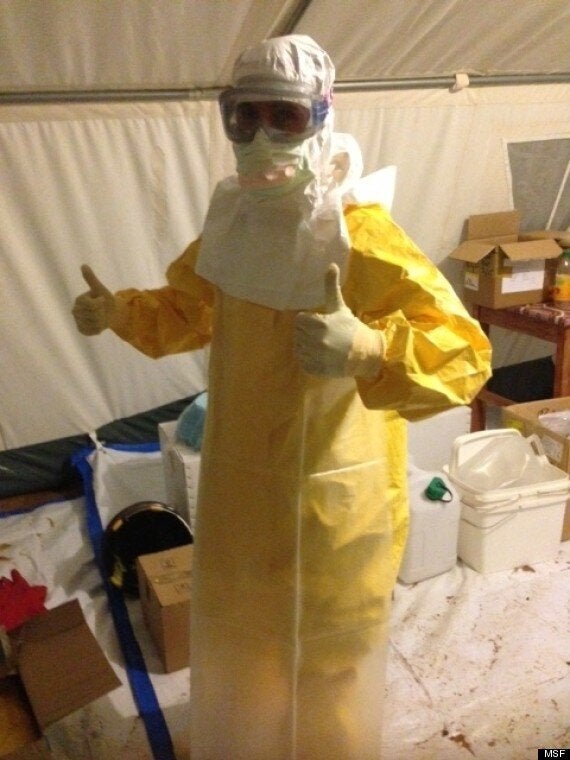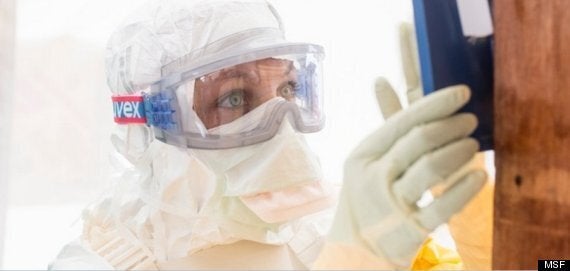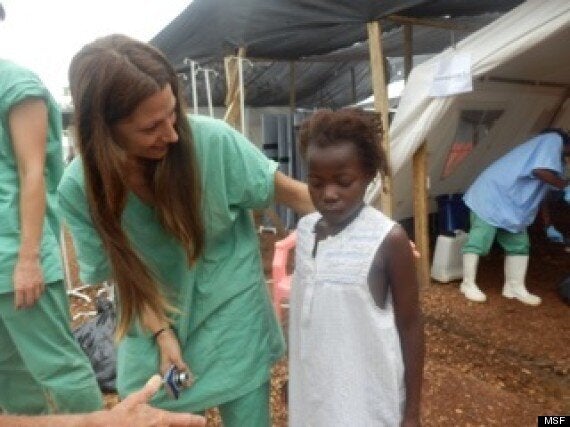"I never considered not going," Dr Grazia Caleo said, nonchalantly, days after she landed back in London. "I had to go. I always said that if I was infected I would not come home, I would stay with my patients in Kailahun. I don't want to be alone with this disease in Europe, I want to be with them."
Caleo, an epidemiologist, had travelled into the heart of an epidemic from which thousands of people had fled. With Médecins Sans Frontières, she has spent a month in Sierra Leone, close to the borders of the other infected nations of Guinea and Liberia. She is not only carrying out her main duty of evaluating how the disease has spread and how to contain it, but also spent days inside her yellow protective suit, cleaning wards and caring for people who know they were dying.
She is one of dozens of Western medics who are prepared to risk their own lives to care for the West African communities in crisis. This outbreak is now officially the worst in history, with the number of those dead from the disease having risen to at least 932, according to the World Health Organisation.

Grazia Caleo in Kailahun, Sierra Leone
Caleo said she tried to avoid any thought of the risks to her own health. "On the plane out there, my mind was full with the thoughts of work, how to set up in the field, not of the risk," she said. "It is a risky disease, the consequences if you get infected are very serious but at the same time, my work is all about limiting transmission of the disease, to patients, to us. You have to be cautious all the time, we know the risk we expose ourselves to. But I feel safe with MSF, they are very reassuring."
Another working in the field with MSF is 32-year-old Benjamin Black, a Manchester-born doctor who found himself in the midst of the emergency while on elective. Black said, in a dispatch from Sierra Leone, there had been many instances where circumstances meant he had feared contamination even with the water-tight precautions in place, and described carrying small vials of blood from Ebola patients "triple packed in sealed and chlorinated containers" in a car for "fours hours of being thrown around on the uneven road".
"l was keen to dispatch of the package as quickly as I could," he said.

The protective suit worn by Black as he treats patients
Ebola Victims Bodies Left To Rot In The Street As Outbreak Declared Worst Ever
In This Very Challenged Region, Ebola Is Evolving Into a National Disaster
During her time there, Caleo said she saw many local medical staff succumb to the disease, which she found difficult to cope with. "Dying of Ebola is a terrible thing, they bleed internally, the blood sometimes seeps outside their body. But what you remember most is not the symptoms of the disease, it is the terror in their faces." She said the victims were conscious of what was happening to them, having seen friends and relatives die in the days before.
Two particular cases stand out, she said, one was a visit to a village where 20 people had already died, including the nurse who was the first one to respond to the disease. "Children are orphaned, both parents have died, and now they too are infected," she said.
Another was a particular little girl she cared for in Kailahun, who arrived late at night in an ambulance having travelled for hours, with the body of her dead mother beside her. "The child could say her own name, the name of her mum but she couldn't even remember the town she lived in. She was traumatised. She died a few days later too."
Education is a key part of the role of the MSF team, Caleo said. But there has been some resistance to it. Last month, the Red Cross in Guinea said it had been forced to suspend operations after staff there were threatened by a knife-wielding gang in the southern town of Gueckedou. In Macenta, in southeastern Guinea, an angry mob attacked an MSF clinic, accusing the aid workers of bringing in Ebola.

The protective suits have sometimes caused problems with local people
It was not something Caleo experienced. "We have tried to visit every village we can where we know patients have come from. They most asked why we never came before, they had run to the other villages to seek help, they had crossed over to Liberia for help, they went to traditional healers, they didn't know you shouldn't do this. Everyone just needs support and explanation, everyone there is living through post-traumatic stress."
Black said he had a similar experience. "I was greeted by smiling waving children and adults nodding in acknowledgement of who I, and what the car I was in, represented. It was clear that the vast majority were relieved to see they were not alone in this uncertain time."
Though the death rate can be as high as 90% for certain strains of Ebola, Black said he had seen many survivors. "I have no intentions of underplaying the severity of this horrendous disease, but the fact remains that there seems to be two types of Ebola patients - the well and the unwell. I was ready for the pitiful sight of grown men weakened and dying, to see people wilted from profuse diarrhea and external bleeding," he said.
"And of course I saw those haunting sights, but I also found groups of young people sitting around talking and eating together, listening to the radio and playing cards. This was the other face of Ebola, the surviving class."
Caleo said that seeing people survive the disease had made her more cautious about the idea of offering up "experimental" treatments for the disease, such as theuntested Zmapp serum, developed by a San Diego pharmaceutical company, given to two American victims.
Many scientists have previously advocated giving untested treatments out to patients who are otherwise likely to die. "I'm not sure I agree," she said. "People are recovering from Ebola, we don't want to give people something that could potentially harm their chance of survival. We should push to increase access to safe and effective treatment, but we still don't know what the outcome of these serums will be on those patients in America."

Caleo said most people are not hostile, and want to find out how to keep the disease contained
"No, we don't have a treatment or a vaccine and that is frustrating. But at least we can offer them some support. We are curing people; we had 52 people in our ward that recovered. It is thanks to their immune system in part, but also due to the clean environment, preventing other infections. We are also stopping people from contaminating their communities and families."
It is currently the rainy season, and Black described daily thunderstorms hammering on the corrugated iron roofs as the doctors work. "The sheer rage of the storm reflects to me the desperate state that we are in right now, trying to permeate through the different layers of society the reality of the epidemic slowly sweeping down the country," he said. "The resistance to believe that another health challenge, in this very challenged region, is evolving into a national disaster. Some of the loudest and longest storms feel like they will never end, but eventually they always do.
"The same is true of an Ebola epidemic, the natural history of the disease leads to violent outbursts of illness and death however it will ultimately burn itself out. It remains to be seen though how far this storm will spread, and what will be left standing and what will be washed away."